Is downtown Rochester's resurgence real? The city's population hasn't been growing. While nightlife – from bars to theater and music – remain healthy, the office rental market is weak. Traditional downtown retail continues to be thin, and Hart's Local Grocers, which was thought to be a sign of hope for retail, closed last week.
And yet the growth in development downtown is obvious. It isn't happening at the pace or on the scale of development in Manhattan, but it's visible, and it's continuing.
The lion's share is in residential development, most of it in former commercial buildings being converted into apartments. And much of the new residential development has filled up. The vacancy rate in the downtown apartments continues to be low, says the city's director of development services, Dana Miller.
Whether the growth is sustainable may not be known until the projects still being planned are open and the dust settles. Downtown's current residential population is estimated at about 7,000, and the Rochester Downtown Development Corporation estimates that another 3,000 will be living there by 2021, based on projects that have been announced or are under way.
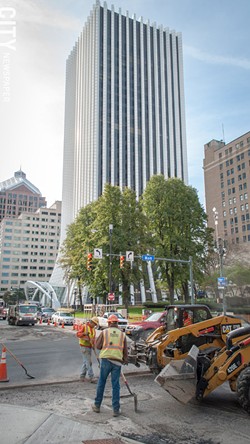
- PHOTO BY RYAN WILLIAMSON
- Gallina Development converted the former Chase bank building into commercial space and apartments.
Apartments in Tower280 (formerly Midtown Plaza's office tower), Sibley's, and Charlotte Square continue to be in demand. Nearly all of the apartments on the 17th through the 21st floors of the Metropolitan – the first residential floors completed in the former Chase bank building – are occupied, says Gallina Development's marketing director, Lauren Gallina. A sixth floor is expected to be ready for rental in June, and apartments in the last four residential floors will follow.
DHD's glass-fronted building on Elm Street overlooking Parcel 5, 88 on Elm, has 36 one- and two-bedroom, market-rate apartments. The Hive, Buckingham's complex on St. Paul Street, has 54 studio lofts and nine one- and two-bedroom lofts. Buckingham also owns loft apartment buildings on Water Street and the large Buckingham Commons on Allen Street, overlooking Frontier Field.
Conifer Realty has bought the Manhattan Square and Savannah apartments, just east of Martin Luther King Jr. Park, and plans major upgrades to those buildings. Both will remain 100 percent affordable housing, Miller says.
Several former industrial buildings in the Cascade District, on the western edge of the Central Business District, were converted into loft apartments years ago. The Gibbs Street neighborhood, whose residents pioneered the mid- to late-20th-century downtown housing rejuvenation, has stayed in demand.
And developers continue to plan new apartments, from the eastern edge of downtown to the western edge.
"I keep hearing from folks, 'Is there really enough demand for these units?" Miller says. He points to the current low vacancy rate. And, he adds, city officials ask for market data from each developer wanting to create more.
Critics have also complained about the high rental rates in many of the downtown apartments. City officials are trying to encourage a diverse mix of housing, requiring developers to offer affordable rates in some of some units if they need city tax benefits. And developers have begun to respond.
Owner-occupied housing downtown continues to be in short supply. There are townhouses in the Gibbs Street area and single-floor condominiums in the Sagamore on East Avenue, but vacancies are unusual. Charlotte Square's new condominiums sold out immediately.
Initially, condominiums were planned for the top floors of the Metropolitan, but creating condos and rental units in a single building with shared common space proved too complicated, legally. And at the moment, despite a demand that officials and some developers think exists, no new owner-occupied housing is planned downtown.

- PHOTO BY RYAN WILLIAMSON
- Nearing completion on the northernmost Inner Loop parcel: Home Leasing’s affordable housing development.
Downtown's soft spot continues to be commercial and office uses. Office vacancy rate was about 25 percent, according to the most recent survey by the Rochester Downtown Development Corporation, published in March 2018. A big challenge: Xerox Tower, owned by Buckingham Properties and now completely vacant.
There have been successes; much of the Metropolitan's 16 floors of commercial space is rented – six floors of it to the Connecticut-based tech firm Datto. The top floor of the former Sibley's department store houses NextCorps, formerly known as High Tech Rochester. CGI Communications, a video production and digital marketing company, owns and occupies the Granite Building at the corner of Main and St. Paul Streets, and the company has bought the building adjacent to it, anticipating continued growth.
The architecture, engineering, and planning firm Bergmann Associates is in Tower 280, as are tech firm Second Avenue Learning and ad company Brand Networks. Butler Till media and communications company is moving its headquarters from Jefferson Road to Parcel 2 of the Midtown Plaza site.
And responding to the market for young-adult services, Central Rock Gym, a rock-climbing company founded in Massachusetts, opened last week in Buckingham Properties' huge project called Alexander Park North, on the former Genesee Hospital site.
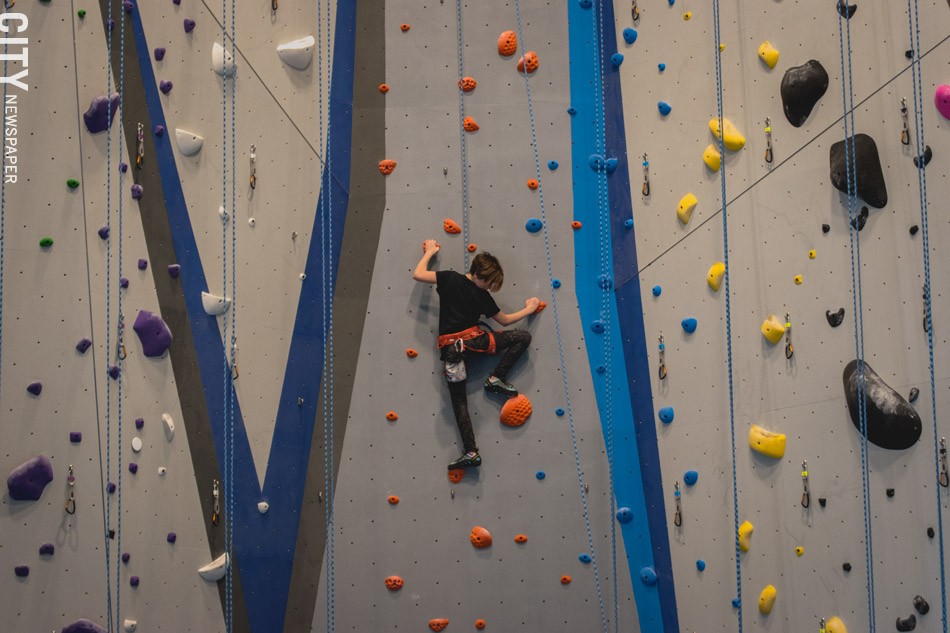
- PHOTO BY RYAN WILLIAMSON
Retail growth, though, may be a long way away. "I don't think we have a population density for thriving retail yet," says the mayor's chief of staff, Alex Yudelson.
And while residents of downtown and nearby city neighborhoods say they want retail stores downtown, says Dana Miller, they often mean they want big retail stores. Thanks to the extensive conversion of downtown buildings into housing, Miller says there's little space for large retail development.
The big unknowns
The future of two big development sites is still unclear: Parcel 5 of the former Midtown Plaza land and the Main Street-riverside land currently occupied by the Radisson Hotel. And a third unknown, the future of a proposed new venue for the Rochester Broadway Theatre League, has been linked to both sites.
Parcel 5: Plans for a new RBTL theater and an apartment tower fell victim to legal problems facing the apartments' developer, Morgan Communities. Now city officials aren't sure what will go there, but thanks to activists' efforts and market forces, officials' thinking has changed dramatically.
"I don't think brick-and-mortar filling the whole space is on the table," Yudelson says. Instead, future development at Parcel 5 is likely to be a combination of traditional development and open space. Downtown, Yudelson says, "has changed in the past five years."
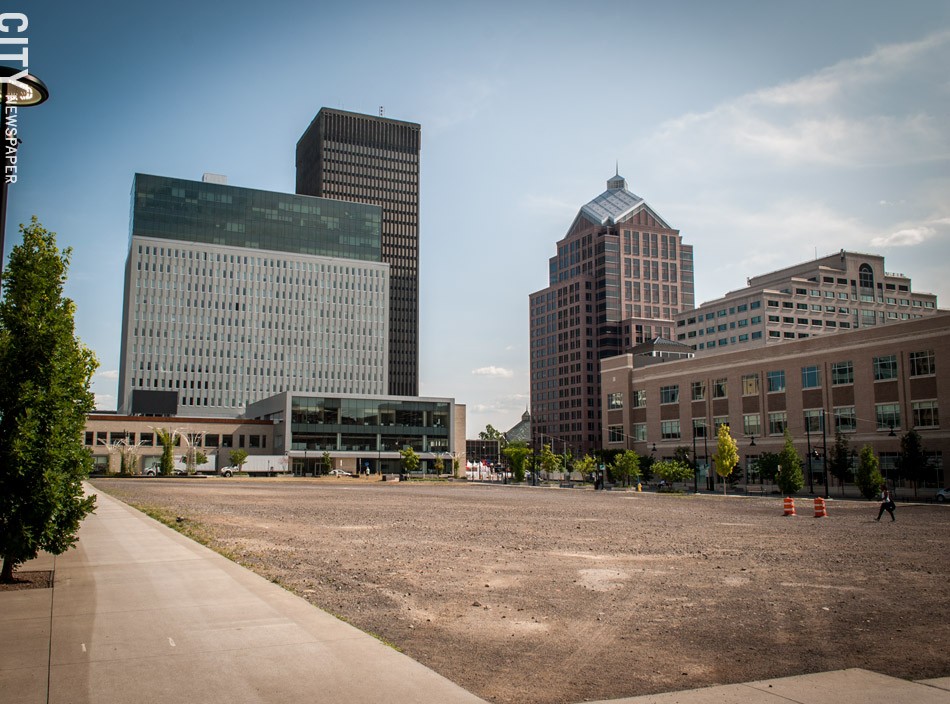
- PHOTO BY RYAN WILLIAMSON
- City officials have changed their mind about Parcel 5’s development. It’ll be some kind of “community gathering place.”
Since the collapse of the theater-apartment proposal, officials have been seeking other options. They've been talking to developers and to activists who have pushed for keeping Parcel 5 as open space – and they've been looking at developments in other cities. In December, the mayor and other officials went to Kansas City to see its Kansas City Live development, which consists of small bars and restaurants surrounding a large covered space used for concerts and similar community events.
Rochester officials' interest in adapting Kansas City Live to Rochester seems strong. They envision a year-round entertainment site, and they say they think it can be built in a way that the sound from concerts and other events won't disturb the growing number of apartment residents on the site's periphery.
The next step: Once the city has a sense of a Rochester version of Kansas City Live, the city will start having public meetings about Parcel 5's future, presenting possible uses and getting the public's reaction. That's likely to take place in the next couple of months, Yudelson says.
Whatever happens, Yudelson says, "it definitely needs to be scaled appropriately." And, he says, "stakeholders and City Hall agree that should be a community gathering place."
The Radisson site: The Radisson Hotel, which in previous iterations has also been a Holiday Inn, has an ideal location. It's on the river, and it's directly across Main Street from the Riverside Convention Center, with an enclosed skyway linking the two. Conventions have relied heavily on it.
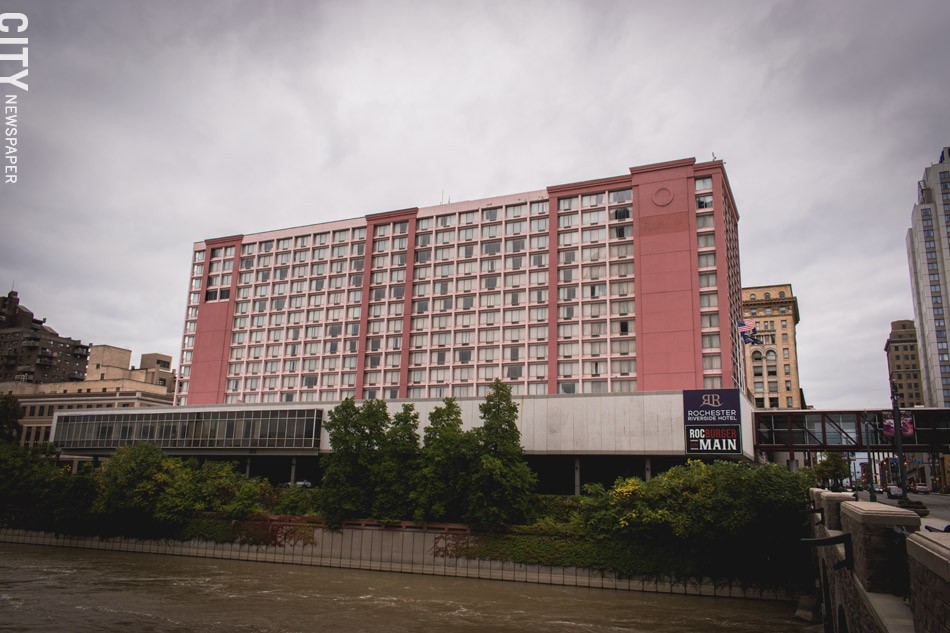
- PHOTO BY RYAN WILLIAMSON
- The Radisson Hotel will likely be demolished and replaced with a new hotel. Other uses are still uncertain.
But the Radisson, built in 1970, has deteriorated – so much so that Rochester has been losing conventions because of the hotel's condition. Developer Dave Christa now owns it and hopes to demolish it and build a new one.
In October, city officials thought they had an ideal solution: package the hotel, its garage, a new theater for RBTL, renovations on the riverside Charles Carroll and Gateway Parks – which were already planned, as part of the Roc the Riverway project – and get some state funding to help create it. Maybe add an apartment tower, whose units would have a river view.
Convention center officials were also happy, because they've wanted additional meeting rooms and, for some conventions, a theater venue.
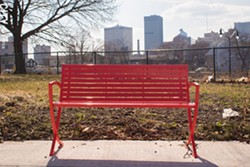
- PHOTO BY RYAN WILLIAMSON
Standing in the way: uncertainty about funding. Throughout the Rochester Broadway Theatre League's long search for a new theater, a big obstacle has been money. And financing plans for construction have often included getting substantial state money.
That's certainly the case now. Even when Paychex founder Tom Golisano was planning to donate $25 million for a new theater, RBTL wanted state funding as well. Once Golisano withdrew his pledge – which happened only a few weeks after city officials announced the new location for the theater – state funding apparently became essential.
The city has requested $50 million in state funding for its Roc the Riverway project, and officials think some of it could be used for the hotel-theater-garage-park project. They hoped the money would be included in the state budget.
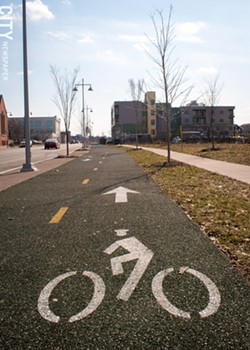
- PHOTO BY RYAN WILLIAMSON
- The bike path along Union Street is part of an effort to create a more bike-friendly city.
The deadline for the legislature to pass the budget is March 30. But the state is facing a $2.3 billion budget deficit, education activists and many others are pushing for more funding, and some economists are predicting a recession. In addition, the legislature, now under complete control of Democrats, has been sparring with the governor. There's no guarantee that the budget will be approved on time – or that Roc the Riverway money will be included in it.
Work on the Radison is likely to take place, regardless: it's not in good shape, and that's affecting Rochester's convention business. But if the state doesn't provide money for Roc the Riverway, or if some of that money can't be used to build RBTL's theater, RBTL will apparently have to come up with the money on its own.
RBTL is continuing its private fundraising efforts, but there's been no announcement about a major donation that could replace Golisano's pledge.
RBTL's executive president, Linda Glosser, sent this statement last week in response to a question about the group's fundraising status: "We continue to work with potential contributors, and we are hopeful that the state's participation will help this wonderful downtown revitalization project. We are anxious for demolition [of the hotel] to be scheduled which in turn will help us develop a timeline for donors."
Open or well under way
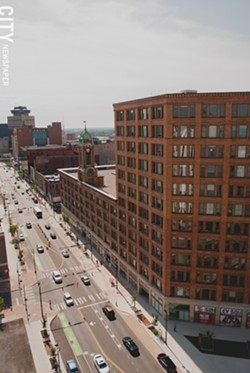
- PHOTO BY RYAN WILLIAMSON
- Sibley Tower houses market-rate apartments, affordable units for older residents, and, under development, “workforce” housing.
Sibley Tower apartments, Phase 3: Winn Development has been successful renting its unique one, two, and three-bedroom, market-rate apartments in the former Sibley tower building. And it has developed another section of affordable housing in the Sibley tower for people 55 and older. Now it's creating a third set of 100 apartments for what Dana Miller calls "workforce" housing: units with rentals in the $1200 to $1400 range, aimed at the growing number of employees working downtown.
"That's an area that we've struggled a bit with," Miller said.
Charlotte Square on the Loop: Adjacent to Home Leasing's first two Charlotte Street developments – market-rate apartments and condominiums – construction is almost complete on the firm's affordable housing development: 50 studio, one-, and two-bedroom apartments and townhouses on the Inner Loop infill between Union and Pitkin Streets. Apartments will be available to residents with incomes 40 to 90 percent of the area median income.
The Nathaniel: Morgan Communities' development on the river at Court Street and South Avenue, with 119 one- and two-bedroom market-rate apartments, is nearly complete and is projected to open in August.
The Linc: The former Alliance building on Main Street at Stone Street, developed by DHD Ventures, has 130 market-rate studio, one-, and two-bedroom apartments. Several floors are already occupied, and more are being developed.
The Terminal Building: DHD has developed this building on Broad Street, between Exchange Street and South Plymouth Avenue, into 56 one-, two-, and three-bedroom market-rate apartments.
The Residences at the Columbus Building: DHD's conversion of the former Knights of Columbus Building, at Chestnut and Lawn Street is almost complete, will have studios and one-bedroom apartments.
Under way or coming soon
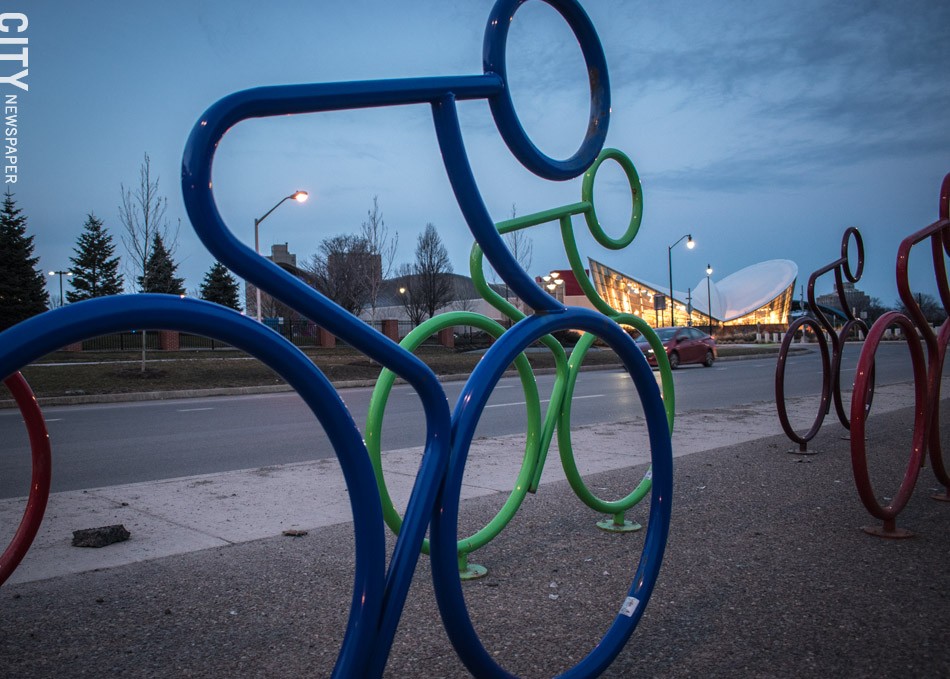
- PHOTO BY RYAN WILLIAMSON
- In addition to the push for new housing and commercial uses, downtown development efforts have included streetscape improvements like benches and bike racks.
The Strong "complex": The Strong museum will anchor a major development extending to the north and east of the current building. There'll be an expansion of the museum, a garage, a hotel, apartments, and commercial units. Construction is already under way on the garage, which is on part of the Inner Loop infill, and on the apartments – 20 percent of them classified as "affordable" – developed by Konar Properties.
Other Inner Loop redevelopments: The infill parcel on the north side of East Avenue has been prepared for a Christa development of market-rate housing. And on the south side of East Avenue, Trillium and Home Leasing will create an unusual residential development. Some apartments will be market-rate housing, and others will be affordable, some set aside for people recovering from addiction or returning from incarceration. And Trillium will operate a pharmacy.
49 Stone Street: A Schenectady-based LLC is converting the small building on this side street off Main Street to 20 one-bedroom apartments and one studio apartment.
Main Street between St. Paul Street and Clinton Avenue: CGI owns the two large buildings on the western end of this block: the Granite Building and the adjacent Gateway Building. But the eastern portion of the block consists of eight individual properties, some of which have been an eyesore for years. Several different developers have bought them and are planning to renovate them and convert them into apartments, retail, and restaurants.
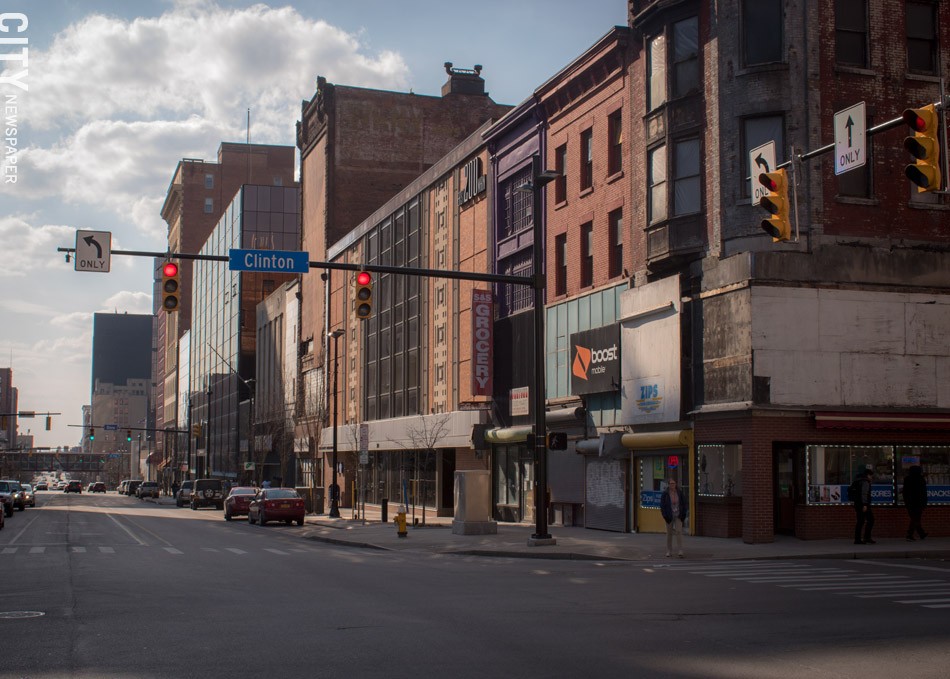
- PHOTO BY RYAN WILLIAMSON
- On the list of “planned” projects: renovation of the string of deteriorated buildings on Main Street at Clinton Avenue.
The Inn on Broadway: Plans include additional hotel rooms as well as new market-rate apartments.
Along the river
Also ready to start is the first part of the city's ambitious Roc the Riverway initiative. Design is beginning or is under way on the first 13 of the components – and full funding has been secured for all but one of them, so construction work will begin on some of them soon.
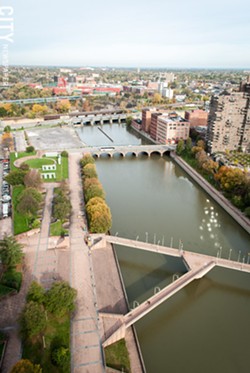
- PHOTO BY RYAN WILLIAMSON
- Charles Carroll Park along the river north of Main Street will get a major upgrade.
Among the largest is a redo of Charles Carroll Park and Genesee Crossroads Park, the linear public areas along the river between Main Street and Andrews Street. The parks are being updated to make them more accessible and easier to use for events and to provide better views of the river. The plan is heading into design now and public meetings will probably start this summer. Construction will likely take three years.
Also in design or heading into design: Blue Cross Arena's expansion, the Convention Center terrace, the Rundel Library terrace, a skate park at I-490, and Genesee Gateway Park (near the Erie Harbor apartments), which will have trail improvements and a dock. Construction is expected to start on most of those projects later this year or early next year, Yudelson says, depending on the weather.
Design has also begun on improvements to the riverside trail in High Falls Terrace Park, adjacent to Genesee Brewery, and officials hope it'll be completed and ready for public use early in 2020.
Yet to start: design work on the redo of the Broad Street bridge, the lower portion of which is a historic Erie Canal aqueduct. City officials hope to remove the street and convert the bridge to a pedestrian walkway and gathering place, but it'll be a complicated project – and a controversial one. Aqueduct enthusiasts hope to preserve the aqueduct in its current covered state.
Funding for the design has been secured, but not for the work itself. Once the city knows how much money is available, preliminary design will start, Yudelson says, and the city will ask for public input.
